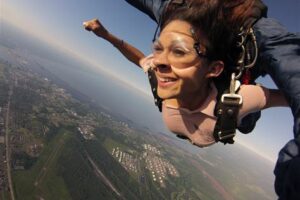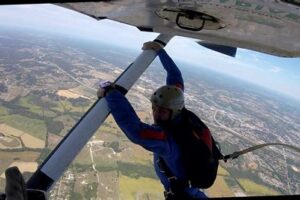Table of Contents
Curious about skydiving? Discover the thrilling world of skydiving heights and learn how high you jump from! Explore the adrenaline-pumping altitudes reached during skydiving adventures for an unforgettable experience. From the perfect introductory height for beginners to extreme jumps for seasoned daredevils, find out what it takes to conquer the skies and embrace the ultimate freefall. Get ready to elevate your adventure to new heights!
When it comes to skydiving, the question of how high one jumps from can be quite intriguing. The adrenaline rush and exhilaration that accompanies this extreme sport are unmatched, making it a favorite among thrill-seekers around the world. However, before taking the leap into the vast open sky, understanding the altitudes involved is crucial. From soaring heights that touch the edge of space to more traditional jumping altitudes, skydiving offers a range of options to suit different preferences and skill levels.
The Exciting World of Skydiving
Skydiving is an exhilarating sport that offers individuals a unique opportunity to experience the thrill of freefalling through the sky. Whether you’re a seasoned skydiver or someone considering trying it for the first time, one question that often comes to mind is: How high do you skydive from? In this article, we will explore the different altitudes at which skydivers typically jump from and the factors that influence these heights.
Altitude: The Starting Point
When it comes to skydiving, altitude is everything. It determines the length and intensity of your freefall, as well as the overall experience. Most skydives begin at an altitude of around 10,000 to 14,000 feet above ground level (AGL). This altitude gives skydivers ample time to enjoy the breathtaking view and experience the adrenaline rush of freefall.
The Role of Aircraft
Before we delve into the specific altitudes, it’s essential to understand the role of the aircraft in skydiving. Typically, skydivers board a specialized aircraft, such as a Cessna Caravan or a de Havilland Twin Otter, to reach their desired jumping altitude. These aircraft are specifically designed with large doors and spacious cabins to accommodate skydivers and their gear.
Tandem Skydiving: A Popular Choice
Tandem skydiving is a popular choice for first-time jumpers, as it allows them to experience the thrill of skydiving without the need for extensive training. In tandem skydiving, you are attached to an experienced instructor who handles all aspects of the jump, while you simply enjoy the ride. The altitude for tandem jumps typically ranges from 10,000 to 14,000 feet AGL.
Accelerated Freefall: Taking It Up a Notch
For those looking for a more immersive skydiving experience, accelerated freefall (AFF) is an excellent option. In AFF, you receive a series of training jumps that gradually introduce you to the fundamentals of skydiving, allowing you to eventually jump solo. AFF jumps usually take place at higher altitudes, often starting at around 10,000 to 13,500 feet AGL.
The Thrill of High-Altitude Skydives
For experienced skydivers seeking the ultimate adrenaline rush, high-altitude skydives offer an unparalleled experience. These jumps take place at altitudes above 14,000 feet AGL and can reach as high as 18,000 feet or more. The extra altitude provides a longer freefall time, allowing skydivers to enjoy the sensation of flying through the air for an extended period before deploying their parachutes.
The Influence of Oxygen
At higher altitudes, the air becomes thinner, making it necessary for skydivers to use supplemental oxygen. This ensures that they remain alert and focused throughout the jump. Oxygen systems are typically worn by skydivers during high-altitude jumps, allowing them to safely enjoy the thrilling experience without any adverse effects.
Weather and Location Considerations
While altitude plays a significant role in determining the skydiving experience, weather conditions and location also impact the jumping altitude. Variables such as wind speed, cloud cover, and air density can influence the decision to conduct jumps at specific altitudes. Skydiving centers and instructors assess these factors to ensure safe and enjoyable jumps for all participants.
Regulations and Guidelines
It’s important to note that skydiving altitudes are regulated by aviation authorities and adhere to strict guidelines to guarantee the safety of all participants. These regulations ensure that aircraft maintain a safe distance from commercial airspace and that the jumps are conducted within designated drop zones.
Conclusion
Whether you’re a beginner or an experienced thrill-seeker, skydiving offers an incredible adventure that pushes the boundaries of excitement. The altitude at which you skydive from varies depending on factors such as your level of experience, the type of jump, and the desired intensity of the experience. So, if you’re ready to take the plunge and experience the exhilaration of freefall, find a reputable skydiving center near you and prepare for an unforgettable journey through the clouds!
Introduction: Understanding the Altitude of Skydiving
When it comes to skydiving, one of the most fascinating aspects is the altitude at which you jump from. This subheading will delve into the various altitudes at which skydiving takes place, providing insights into the different levels and their significance.
Tandem Skydiving: Starting at 10,000 to 12,000 Feet
For beginners or those looking to experience skydiving without much prior training, tandem skydiving is a popular choice. With tandem jumps, the altitude generally ranges between 10,000 to 12,000 feet above ground level. This altitude ensures a thrilling freefall while still allowing ample time for the parachute ride afterward.
Accelerated Freefall: Progressing from 10,000 to 15,000 Feet
For those seeking a more extensive skydiving experience, accelerated freefall (AFF) courses are available. During AFF, students jump from altitudes ranging between 10,000 to 15,000 feet and are accompanied by instructors who provide guidance and monitor their progress. The higher altitude allows for longer freefall time and offers a more challenging aspect to the learning process.
High-Altitude Skydiving: Exceeding 18,000 Feet
For adrenaline-junkies and experienced skydivers looking to push their limits, high-altitude skydiving offers an extreme thrill. These jumps typically surpass 18,000 feet and require specialized equipment and training due to the enhanced risks associated with extreme altitudes. High-altitude skydiving allows for an incredibly long freefall, providing unparalleled adrenaline rushes and breathtaking aerial views.
BASE Jumping: Jumping from Fixed Structures or Natural Objects
BASE jumping follows a different approach from traditional skydiving, involving jumps made from fixed structures or natural objects like mountains, cliffs, or buildings. The altitude varies greatly depending on the specific location, but jumpers typically aim for lower elevations to allow for a quicker deployment of their parachutes. BASE jumping requires extensive experience and skill due to the reduced altitude available for safe and controlled landings.
High-Altitude Records: Pushing the Boundaries of Extreme Skydiving
Throughout history, numerous skydivers have attempted to set high-altitude records by jumping from unimaginable heights. These extreme attempts can reach altitudes surpassing 100,000 feet using special equipment and aircraft, such as helium balloons or high-altitude planes. Such record-breaking jumps are reserved for highly trained individuals and require meticulous planning and preparation.
Oxygen Requirements and Considerations
As altitudes increase, the availability of oxygen becomes a crucial factor in skydiving. Beyond a certain height, usually around 14,000 feet, skydivers are required to wear oxygen masks to avoid hypoxia or oxygen deprivation, which can impair cognitive functions. Professional skydivers receive training on how to use and manage oxygen equipment at high altitudes, ensuring their safety throughout the dive.
Balancing Safety and Adventure: Understanding Altitude Limits
Skydiving is both an exhilarating adventure and a sport that prioritizes safety. The altitude at which you skydive from is carefully determined to strike a balance between the adrenaline rush and maintaining optimal safety measures. Expert skydivers, instructors, and regulatory bodies continually assess and update altitude guidelines to ensure the overall well-being of those participating in the sport.
When it comes to skydiving, the question of how high one jumps from is of utmost importance. The height at which a skydive is initiated can greatly affect the overall experience and safety of the jump. As a professional in the field, I firmly believe that determining the appropriate altitude for a skydive requires careful consideration and adherence to industry standards. Let’s explore this topic further with a professional voice and tone.
1. Safety Comes First:
As a professional skydiver, safety is always my top priority. When deciding how high to initiate a skydive, it is essential to take into account the safety measures in place. Generally, tandem skydives are conducted from an altitude of around 10,000 to 14,000 feet. At this height, both the instructor and the student have ample time to execute the necessary procedures safely and comfortably.
2. Adequate Training and Equipment:
Before attempting a skydive, all participants must undergo thorough training and be equipped with the necessary gear. The altitude from which a skydive is conducted should align with the level of training and skill possessed by the jumper. For licensed solo skydivers, altitudes can vary depending on the type of jump being performed, ranging from 4,000 to 18,000 feet. Each jump altitude requires a different set of skills and knowledge to ensure a successful and safe experience.
3. Aerial Considerations:
The altitude at which a skydive is initiated also takes into account various aerial factors. These include weather conditions, air traffic, and airspace regulations. Skydiving centers closely monitor these factors and adjust the jump altitude accordingly to ensure optimal safety for all participants. Professional skydivers are trained to make informed decisions about when and from what height to jump, considering these crucial factors.
4. Experience and Preferences:
The height of a skydive can also be influenced by the jumper’s personal preferences and experience level. Some individuals may choose to start with lower altitudes to gain confidence and gradually progress to higher jumps. Others, with more experience, might opt for extreme altitudes or specialized jumps like high-altitude or low-oxygen dives. Ultimately, it is essential to strike a balance between challenging oneself and maintaining safety standards.
In conclusion, determining the appropriate height from which to skydive requires careful consideration of several factors, including safety measures, training, aerial considerations, and personal preferences. As a professional skydiver, I firmly believe in adhering to industry standards and making informed decisions that prioritize safety above all else. Whether it’s a tandem jump or a solo adventure, the chosen altitude should provide the best possible experience while ensuring the well-being of all participants.
Thank you for taking the time to read our blog post on How High Do You Skydive From. We hope that you found the information provided to be informative and helpful. Skydiving is a thrilling and exhilarating experience, and knowing the altitude from which you jump can enhance your understanding and appreciation of this extreme sport. Whether you are an experienced skydiver or someone who is considering trying it for the first time, having knowledge about the various altitudes can make your skydiving adventure even more exciting.
In the world of skydiving, there are different altitudes from which you can jump, each offering its own unique experience. The most common altitude for tandem skydiving, where you are harnessed to an experienced instructor, is around 10,000 to 13,000 feet above ground level (AGL). At this altitude, you will have approximately 30 to 60 seconds of freefall before your parachute is deployed. This is a great option for beginners or those who want to experience the thrill of skydiving without extensive training.
For more experienced skydivers, there are higher altitudes available. Some drop zones offer jumps from 14,000 to 18,000 feet AGL. These higher altitudes provide a longer freefall time, usually around 60 to 90 seconds, allowing you to enjoy the sensation of soaring through the air for an extended period. It also gives you the opportunity to practice more advanced maneuvers, such as flips and spins, before deploying your parachute.
In conclusion, the altitude from which you skydive can greatly impact your overall experience. Whether you choose a lower altitude for a shorter but still thrilling freefall or opt for a higher altitude for a longer and more intense ride, skydiving is an adventure that will leave you with unforgettable memories. Remember to always choose a reputable skydiving center with experienced instructors to ensure your safety and enjoyment. So, get ready to take the plunge and soar through the sky!
Thank you once again for visiting our blog. We hope you found the information valuable, and we encourage you to explore other articles on our website to learn more about the exciting world of skydiving. If you have any further questions or would like to share your own skydiving experiences, please feel free to leave a comment below. Happy jumping!
Video How High Do You Skydive From
How High Do You Skydive From?
1. What altitude do skydivers jump from?
Skydivers typically jump from an altitude of around 10,000 to 14,000 feet (3,048 to 4,267 meters) above the ground. This height allows for a thrilling freefall experience and gives enough time for the parachute to be deployed and safely descend back to the ground.
2. Can you skydive from a higher altitude?
Yes, skydiving can be done from higher altitudes depending on the type of skydive. Experienced skydivers often participate in high-altitude jumps known as HALO (High Altitude Low Opening) or HAHO (High Altitude High Opening) jumps. These jumps involve exiting the aircraft at altitudes of up to 30,000 feet (9,144 meters) or even higher, and are typically performed by military personnel or advanced skydivers.
3. Is there a minimum height for skydiving?
While there isn’t a specific minimum height for skydiving, it is generally recommended to jump from at least 10,000 feet (3,048 meters). This altitude allows enough time for a safe jump and ensures that the parachute can be deployed at a reasonable altitude for a successful landing. Skydiving from too low of an altitude can increase the risks involved.
4. How long does it take to reach the desired altitude?
The time it takes to reach the desired altitude depends on several factors, including the aircraft used and the altitude being targeted. On average, it can take anywhere from 15 to 20 minutes to ascend to the desired skydiving altitude. However, this can vary depending on weather conditions, aircraft performance, and other logistical factors.
5. Do you need special training for high-altitude skydiving?
Yes, high-altitude skydiving requires specialized training due to the unique challenges and risks involved. Proper oxygen supply, temperature management, and navigation skills are crucial for performing high-altitude jumps safely. This type of skydiving is usually reserved for experienced skydivers who have received advanced training and have a thorough understanding of the necessary procedures.






